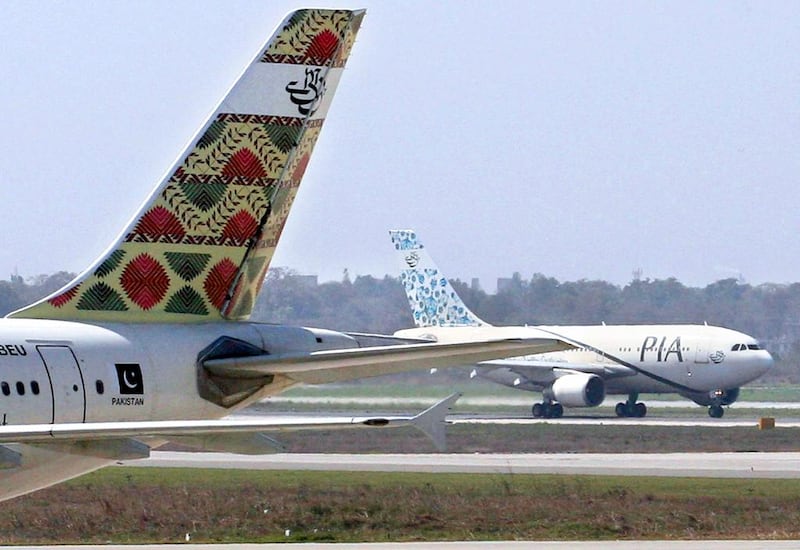Twenty-nine years ago, Pakistan International Airlines (PIA) helped Emirates Airline get off the ground by lending it two planes, an Airbus A300 and a Boeing 737. At the time PIA was an established moneymaker and Emirates a four-plane fledgling. Since then the two carriers have flown in opposite directions, and now PIA is hoping that an Arabian Gulf airline such as Emirates will buy a stake in Pakistan’s ailing flag carrier.
Now the Pakistani government has a plan to put PIA on its feet and return it to profitability. It wants to split the company in two.
One unit, including assets such as ground handling and hotels, would be put into a holding company, and sold off gradually.
Meanwhile the airline unit would be hived off and sold to a foreign carrier. Last week the government’s privatisation leader, Mohammad Zubair Khan, mentioned Emirates Airline, Etihad Airways and Qatar Airways as possible buyers.
What has gone wrong with PIA in the past 30 years?
Mismanagement and rampant corruption have turned the airline into a white elephant, eating away the nation’s resources while posting a string of losses. With a debt burden of 276bn Pakistani rupees (Dh9.89bn), the once-prestigious carrier has become a perpetual drain on the national wallet.
In 1991, PIA posted its first loss because of the increase in fuel prices caused by the First Gulf War.
It last turned a profit in 1992, with record earnings of US$41 million on revenue of $880m.
By 2000 it was losing 11bn rupees a year. Since then, the airline’s financial health has progressively deteriorated.
The situation has reached alarming proportions. Financially and administratively, PIA has yet to tackle a plethora of problems and issues ranging from the erosion of its market position, a high fuel price, a burdened balance sheet and a ballooning debt-servicing bill to the ineffective marketing, open-sky policy, increased competition, brand damage, failure in hedging oil prices, use of old planes, overstaffing, ailing corporate culture, negative equity and organisational issues.
There are complaints of inefficiency and poor customer service. The airline has lost international stature. It no longer remains a competitive choice for tourists or business travellers, as they now prefer to travel by Emirates or Etihad.
PIA’s domestic and international flights are regularly cancelled. Pakistani media reported that a pilot delayed a New York-bound flight for more than two hours as he waited for a sandwich delivery. The poor performance and poor customer service is because of the lack of focus of PIA’s crew. Last week, a PIA air hostess was arrested in Italy after drugs were allegedly seized on her at the Milan airport. Last year, a PIA pilot was jailed in the United Kingdom for being three times over the alcohol limit before he was due to fly.
Long gone are the glory days.
PIA was Pakistan’s only airline for many years after its creation in 1955. It was the first Asian airline to operate a jet aircraft and Boeing 737 aircraft.
It is still the country’s largest airline, with 17,000 employees and a fleet of 36 aircraft – out of which 10 are grounded because of a lack of spare parts. The airline operates scheduled services to 23 domestic destinations and 30 international destinations in 27 countries across Asia, Europe and North America.
The airline is 85 per cent owned by the government, while an employees’ trust owns 8 per cent and the remained is traded on the country’s three stock exchanges.
Pakistan’s governments have manipulated PIA for political gain, giving jobs to so many supporters that the size of the workforce has become unsustainable. For example, the airline was overstaffed through appointments on political affiliation during Benazir Bhutto’s second term as prime minister (1993-1996). Under the military government of Pervez Musharraf in 2001, PIA had to deal with a ticket sales scandal costing the airline $45m a year. Successive governments did nothing but fatten the white elephant over the years through cash injections using the public’s money.
Because of the widespread corruption of its higher-ups, PIA signed controversial business deals involving kickbacks, according to the National Accountability Bureau.
In 2012, Transparency International Pakistan requested that the Chief Justice of Pakistan take notice of a host of issues prevalent in PIA such as purchase of aircraft for very high prices and a loss of 410m rupees suffered by the airline because of the cancellation of 1,200 flights between August and November in 2011.
A low point came three years ago. PIA had awarded a multibillion-dollar contract to a little-known Dubai company, Transworld Aviation, to supply spare parts. The company was unable to supply spare parts to PIA at a time when more than 109,000 Haj pilgrims were expected to travel with the airline in 2011, and PIA had to ground nine planes. The contract was cancelled only last year.
After coming into power for the third time last year following the victory of his party in elections, the prime minister, Nawaz Sharif, decided to privatise PIA because the cash-strapped government could not afford to bear a monthly loss of 3.3bn rupees.
Will privatisation redeem the old glory of the national airline? The decision to privatise PIA is opposed by the political parties in the opposition and it is likely to be challenged in the court.
What PIA direly needs is an operational and financial restructuring and ruthless accountability of the corrupt managers to improve its customer service and performance.
Syed Fazl-e-Haider is a development analyst in Pakistan. His books include The Economic Development of Balochistan





